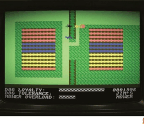
Nintendo is a company known for marching to the beat of its own drum, and its early experiences with handheld consoles go a long way to proving the benefits of that approach. The Game Boy’s four shades of grey may not have dazzled like the colour graphics of the Lynx and the Game Gear, but its affordability and the appeal of Tetris ensured that it comfortably outsold both. When the Game Boy Color finally arrived in 1998, it was actually comparable to the capabilities of those old rival systems, without the hefty battery bill that came with them. Nintendo could afford to move at such a glacial pace because of an absence of serious challengers in the portable console market.
That’s not to say that Nintendo wasn’t exploring its options, though. In early 1996, rumours of Project Atlantis made the rounds in gaming magazines – a 32-bit handheld with a colour screen measuring three inches by two inches, with four buttons. Though it sounds remarkably similar to the Game Boy Advance, this prototype ultimately never made it to market because Nintendo considered it to be too bulky and power-hungry. The Game Boy Color instead succeeded the Game Boy, and work on the Game Boy Advance began soon after. While Nintendo was still firmly in command of the global handheld console market, it couldn’t necessarily afford to proceed at its previous leisurely pace due to the arrival of the WonderSwan from toy giant Bandai and SNK’s Neo Geo Pocket Color.
Development of the Game Boy Advance was handled by the Nintendo Research & Engineering Department in Kyoto, with key names including mechanical designer Masahiko Oota, design manager Kenichi Sugino, hardware designers Ryuji Umeji and Shuichi Tsugawa and system programmer Takanobu Nakajima. Speaking with Nintendo’s official Japanese website in 2000, Tsugawa stated that the hardware was developed in a relatively short span of around two years, with Umeji confirming that around half of that time was spent choosing a CPU. Sugino stated that the horizontal layout of the console was chosen to avoid making it too large, and that a proposed clamshell design was considered too thick.
Rumours swirled for months about the Game Boy Advance before it was officially unveiled. The December 1999 issue of reported thatlife of around 20 hours on two AA batteries. The magazine also reported internet capabilities and connectivity to Nintendo’s forthcoming Dolphin console, and anticipated that the Game Boy Advance “is likely to be the first and only portable machine capable of reasonable 3D graphics”. The March 2000 issue of stated that it offered “the potential for SNES quality games” with graphics that would “match flashy SNES titles like ”. went further in its July 2000 issue, suggesting that , , and were lined up as launch titles.




